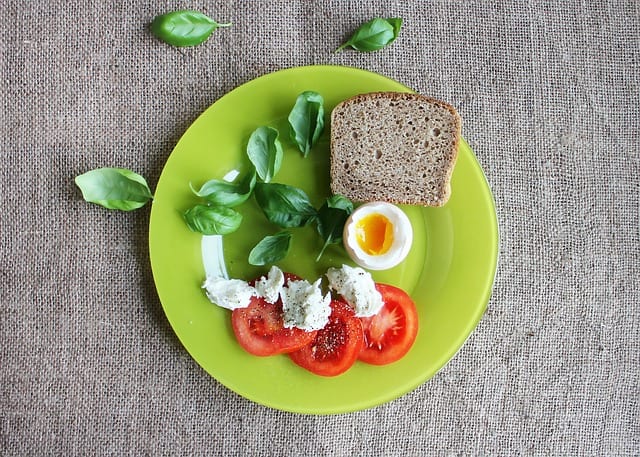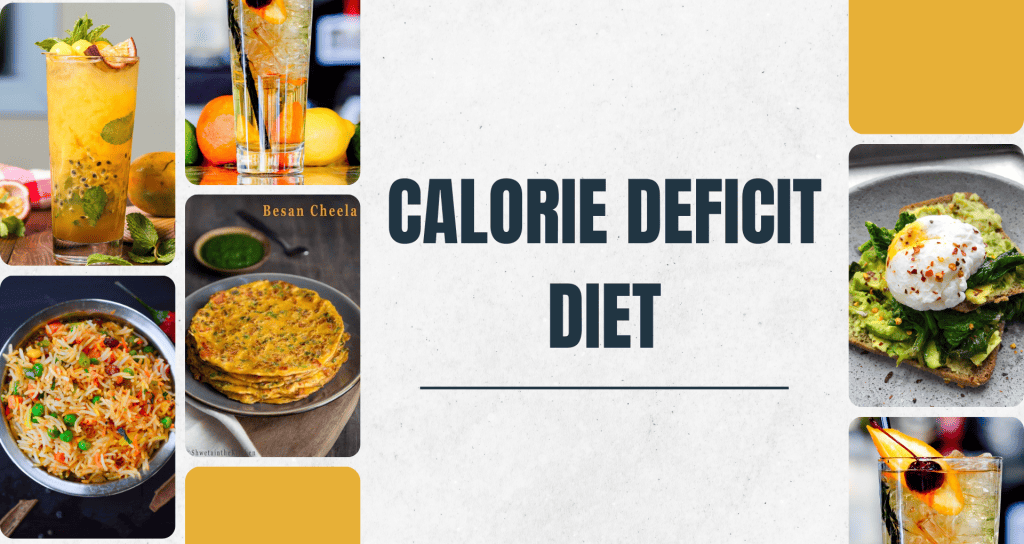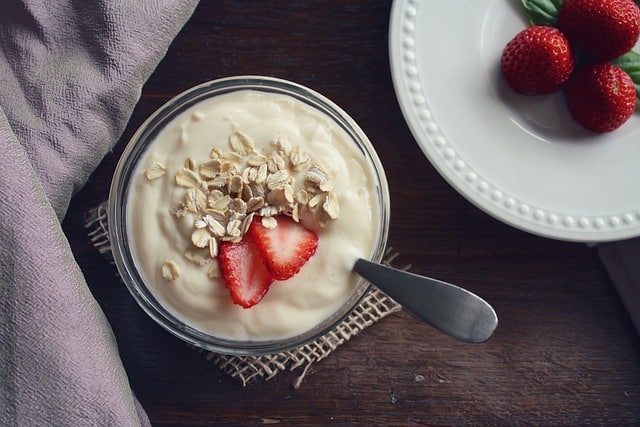Do you know what is calorie deficit? A calorie deficit diet in simpler words is a diet consisting of fewer calories than your daily maintenance calories. A calorie deficit diet is a straightforward, scientifically-backed approach to weight loss, hinging on consuming fewer calories than the body expends. This deficit prompts the body to tap into stored fat for energy, leading to weight reduction. The strategy involves mindful eating, focusing on nutrient-rich, lower-calorie foods like vegetables, fruits, lean proteins, and whole grains while minimizing high-calorie, nutrient-poor items. Regular physical activity augments this calorie deficit, enhancing overall health and preserving muscle mass. While effective for weight loss, it’s crucial to approach this diet in a balanced way to ensure nutritional adequacy and sustainable, long-term health outcomes.
What is Calorie Deficit Diet?
A calorie deficit means you are eating fewer calories than what you are burning. This forces the body to use the already stored energy which eventually helps you to shed weight. Usually, a calorie deficit diet plan is followed along with good amounts of exercise to maximize weight loss results. Usually, people who have just started their weight loss journey may not know what is calorie deficit. If you want to know what is calorie deficit then this blog will help you learn more about a calorie deficit diet and also show you what to eat each day in order to be in a calorie deficit.
Does Calorie Deficit Diet help to lose Weight?
Yes, a calorie deficit diet is a fundamental and effective strategy for weight loss. By consuming fewer calories than the body expends for energy, this diet creates a deficit, forcing the body to utilize stored fat for fuel, leading to weight loss. This approach hinges on balancing nutritional intake with calorie reduction, emphasizing a diet rich in nutrients while being lower in calories. It’s often paired with increased physical activity to boost the calorie deficit further. For sustainable weight loss and health, it’s crucial to maintain a balanced and varied diet, ensuring that the body receives all necessary nutrients while operating on fewer calories and also keep a check at your BMR. To calculate your BMR regularly you can make use of the BMR Calculator.
How to Calculate Calorie Deficit?
If you are looking to lose weight then knowing what is calorie deficit and learning how to calculate your calorie deficit can help you big time. This is how you can calculate your calorie deficit
Step 1: You will first have to calculate your maintenance calories before calculating your calorie deficit. Your maintenance calories in simpler words the number of calories your body needs to maintain its current weight. First, we will be calculating BMR (Basal Metabolic Rate)
For Men: Your BMR = 10*weight(kg) + 6.25*height(cm) -5*age (years) + 5
For Women: Your BMR = 10*weight(kg) + 6.25*height(cm) – 5*age(years)-161
Step 2: The next step will be to select the level of exercise in your life. You have to multiply your BMR with the PAR or Physical Activity Ratio
Here is the Physical Activity Ratio List
| Physical Activity Ratio | |
| Sedentary – 1.55 | |
| Moderately Active – 1.85 | |
| Very Active – 2.2 | |
| Extremely Active – 2.4 |
Step 3: The next step will be to multiply your BMR with the physical activity ratio to get your maintenance calories.
Step 4: Once you are aware of the calories you need in the day you can you can know the calorie deficit for yourself. One lb f fat in the body contains about 3500 calories, which means if a person wishes to lose 1lb of fat from the body they need to be in a deficit of 3500 calories.
There you go! Now you know what what is calorie deficit and how to calculate it. Well you can also make use of the body fat calculator to know the amount of fat you possess and burn it with time.
How does a Calorie Deficit Diet work?
A calorie deficit diet works on the principle of energy balance for weight loss. Here’s how it functions:
- Caloric Needs Assessment: Your total daily energy expenditure (TDEE) is determined. This is the total number of calories you burn daily, including basal metabolic rate (BMR), physical activity, and the energy used in digesting food.
- Creating a Deficit: You consume fewer calories than your TDEE to lose weight. This creates a calorie deficit, meaning your body doesn’t get enough energy from food and starts using stored fat to meet energy needs.
- Rate of Weight Loss: A deficit of about 500 calories per day typically leads to a weight loss of around 0.5 kg (1 lb) per week. This rate is considered safe and sustainable.
- Nutritionally Balanced Diet: While reducing calorie intake, it’s essential to maintain a balanced diet. This means consuming various nutrients, including proteins, carbohydrates, fats, vitamins, and minerals, to support overall health.
- Behavioural Changes: A calorie-deficit diet often involves learning new eating behaviours, like portion control, mindful eating, and making healthier food choices.
- Physical Activity: Exercise can increase calorie expenditure, contributing to a more significant deficit. It also supports muscle health, boosts metabolism, and provides numerous other health benefits.
- Monitoring Progress: Regularly tracking your calorie intake and weight helps adjust your diet plan as needed. This is important because your caloric needs may decrease as you lose weight.
- Sustainability: For long-term success, you must adopt a calorie deficit approach that you can maintain. This often means making gradual, realistic changes to your eating habits and lifestyle. Wondering how many calorie should i eat in a day? Well we got you covered in that prospect.
7 Days Calorie Deficit Diet Plan
Following a great weight loss diet plan is a great way to get started with a calorie deficit diet. It will give you more idea of what to add and what to exclude from your diet.
Do note that before taking a look or following the diet plan given below you have to know what is calorie deficit and maintenance calories which helps you to figure out the exact number of calories you need to eat to be in a calorie deficit.
Calorie Deficit Diet Plan Chart – Day 1
| Calorie Deficit Diet Plan Chart – Day 1 | |||||
| Breakfast | 1Besan Cheela (250 cal) | ||||
| Lunch | Vegetavble Salad (26 cal) | ||||
| Snack | Tea with Makhana (169 cal) | ||||
| Dinner | 1 Multigrain Chapati with Sarso ka Saag ( 240 cal) | ||||
For day 1 you can have the following meals to be in a caloric deficit.
Breakfast
- Besan Cheela : This wholesome food is great for diabetics as it has a low glycemic index and contains fiber which can aid digestion in the body
Lunch
- Vegetable Salad: Vegetables are home to many essential vitamins and minerals like Vitamin C and K. They also protect the body against various diseases.
Snack
- Tea with Makahane: The caffeine in tea provides the body with the required energy and makhanas are a great source of antioxidants.
Dinner
- Multigrain Chapati with Sarso Ka Saag: This meal will provide the body with complex carbs and also boost its immunity.
Calorie Deficit Diet Plan Chart – Day 2
| Calorie Deficit Diet Plan Chart – Day 2 | |||||
| Breakfast | Sprouts Cheela (200 cal) | ||||
| Lunch | Multigrain chapati with Soyabean curry (160 cal) | ||||
| Snack | Tea with Makhane (169 cal) | ||||
| Dinner | Vegetable Quinoa (170 cal) | ||||
For day 2 you can have the following meals to be in a caloric deficit.
Breakfast
- Sprouts Cheela : This can be a great addition to your calorie deficit diet as this meal is not only low in calories but also has many benefits. Sprouts have fiber in them which helps in digestion.
Lunch
- Multigrain chapati with Soyabean curry: Adding this meal to your calorie deficit diet can help you lose weight as multigrain chapati has complex carbs in them and soybean has a low fat and high protein content
Snack
- Tea with Makhane: Makhane is low in calories and has tons of antioxidants that can help the body fight against oxidative stress.
Dinner
- Vegetable Quinoa: The fiber and protein content in quinoa and the essential vitamins and minerals present in vegetables make this meal a great addition to your calorie deficit diet.
Calorie Deficit Diet Plan Chart – Day 3
| Calorie Deficit Diet Plan Chart – Day 3 | |||||
| Breakfast | Curd with Poha (156 cal) | ||||
| Lunch | Rice with Mix Dala and Curd (343 cal) | ||||
| Snack | Tea with Makhane ( 169 cal) | ||||
| Dinner | Brown Rice with Shahi Paneer ( 520 cal) | ||||
For day 3 you can have the following meals to be in a caloric deficit.
Breakfast
- Curd with Poha: Poha is light and contains carbs which provide the body with the much-needed carbohydrates. It also contains Vitamin B1 which helps to stabilize blood sugar levels. Curd helps with digestion and improving immunity.
Lunch
- Rice with Mix Dala and Curd: When it comes it a calorie deficit diet then this meal should definitely be a part of it. Rice has carbs and Mix Dal is a rich source of protein.
Snack
- Tea with Makhana: Tea has caffeine in it which provides the body with energy and Makahan helps the body to fight against oxidative stress as it contains many antioxidants.
Dinner
- Brown Rice and Shahi Paneer: Brown rice is a slow-digesting carb which can be very beneficial for diabetics. Panner on the other hand contains protein with all the essential amino acids.
Calorie Deficit Diet Plan Chart – Day 4
| Calorie Deficit Diet Plan Chart – Day 4 | |||||
| Breakfast | Quinoa Sprouts Upma with Curd (400 cal) | ||||
| Lunch | Chapati with Soyabean ki sabzi (300 cal) | ||||
| Snack | Tea with Makhana (169 cal) | ||||
| Dinner | Methi Partah with Cucumber Raita | ||||
For day 4 you can have the following meals to be in a caloric deficit.
Breakfast
- Quinoa Sprouts Upma with Curd: Quinoa is a good source of fiber. It also contains good amounts of Vitamin D which is essential for maintaining good bone health.
Lunch
- Chapati with Soyabean ki sabzi: Whole wheat chapati is a good source of carbs and soybean is one of the best sources of vegetarian protein.
Snack
- Tea with Makahana: Tea provides the body with energy and makhanas help to control blood sugar levels in the body.
Dinner
- Methi Paratha with Cucumber Raita: Adding this meal to your calorie deficit diet can help in improving digestion in the body.
Calorie Deficit Diet Plan Chart – Day 5
| Calorie Deficit Diet Plan Chart – Day 5 | |||||
| Breakfast | Ragi Dosa with Sambhar and Buttermilk | ||||
| Lunch | Mix Dal and Rice with Curd and Salad | ||||
| Snack | Tea with Makhana | ||||
| Dinner | Vegetable Quinoa | ||||
For day 5 you can have the following meals to be in a caloric deficit.
Breakfast
- Ragi Dosa with Sambhar and Buttermilk: Dosa has a decent amount of protein and butter helps the body with digestion.
Lunch
- Mix Dal and Rice with Curd and Salad: If you have just started weight loss and don’t know what is calorie deficit then having mixed dal in your calorie deficit diet can provide you with a good amount of protein. Curd has Vitamin D and salad has fiber in it.
Snack
- Tea with Makhana: The caffeine in tea helps to make the body more active and having makhana can help to stabilize your blood sugar levels.
Dinner
- Vegetable Quinoa: This meal can definitely be a part of your calorie deficit diet as vegetables have essential vitamins and minerals and Quinao has good amounts of fiber in it.
Calorie Deficit Diet Plan Chart – Day 6
| Calorie Deficit Diet Plan Chart – Day 6 | |||||
| Breakfast | Sprouts Cheela | ||||
| Lunch | Multigrain chapati with soybean curry | ||||
| Snack | Tea with Makhana | ||||
| Dinner | Vegetable Quinoa | ||||
For day 6 you can have the following meals to be in a caloric deficit.
Breakfast
- Sprouts Cheela : Sprouts have good amounts of fiber in them and the cheela made from besan helps in lowering blood sugar levels.
Lunch
- Multigrain chapati with soybean curry: Just started your weight loss journey and don’t know what is calorie deficit then one of the best foods to add to your calorie deficit diet is multigrain chapati as it provides the body with a slow and constant release of energy. Soyabean on the other hand has a good amount of protein in them.
Snack
- Tea with Makhana: Makhanah has various essential vitamins and minerals and tea provides the body with energy.
Dinner
- Vegetable Quinoa: This meal can be a part of your calorie deficit diet as it is low in calories and also has many vitamins and minerals
Calorie Deficit Diet Plan Chart – Day 7
| Calorie Deficit Diet Plan Chart – Day 7 | |||||
| Breakfast | Besan Cheela | ||||
| Lunch | Vegetable Salad with Paneer Tikka | ||||
| Snack | Tea with Makhana | ||||
| Dinner | Multigrain Chapati with Sarso Ka Saag | ||||
For day 7 you can have the following meals to be in a caloric deficit.
Breakfast
- Besan Cheela: With a low glycemic index, this meal is a great option for diabetics who can add this to the calorie deficit plan.
Lunch
- Vegetable Salad with Paneer Tikka: Vegetables are home to various vitamins and minerals and paneer contains protein with all the essential amino acids.
Snack
- Tea with Makhana: Tea contains caffeine which helps the body to feel more energized and makhana is helps the body to fight against oxidative stress due to the many antioxidants present in it.
Dinner
- Multigrain Chapati with Sarso Ka Saag: Multigrain chapati has complex carbs which are far better than refined carbs. Sarso Ka Saag helps to boost immunity in the body.
Quick Glance at 7 Days Calorie Deficit Diet
Let’s take a quick glance at the 7 days calorie deficit diet plan.
| Days | Breakfast | Lunch | Snack | Dinner | |||||
| Day 1 | 1Besan Cheela | Vegetable Salad | Tea with Makhana | 1 Multigrain Chapati with Sarso ka Saag | |||||
| Day 2 | Sprouts Cheela | Multigrain chapati with Soyabean | Tea with Makhane | Vegetable Quinoa | |||||
| Day 3 | Curd with Poha | Rice with Mix Dala and Curd | Tea with Makhane | Brown Rice with Shahi Paneer | |||||
| Day 4 | Quinoa Sprouts Upma with Curd | Chapati with Soyabean ki sabzi | Tea with Makhana | Methi Partah with Cucumber Raita | |||||
| Day 5 | Ragi Dosa with Sambhar, lassi | Mix Dal and Rice with Curd, Salad | Tea with Makhana | Vegetable Quinoa | |||||
| Day 6 | Sprouts Cheela | Multigrain chapati, soybean curry | Tea with Makhana | Vegetable Quinoa | |||||
| Day 7 | Besan Cheela | Vegetable Salad, Paneer Tikka | Tea with Makhana | Multigrain Chapati with Sarso Ka Saag | |||||
Benefits of following a Calorie Deficit Diet
Following a calorie deficit diet offers several benefits, especially when done sensibly and as part of a balanced approach to nutrition and health. Here are the key advantages:
- Effective Weight Loss: The primary benefit of a calorie deficit diet is weight loss. By consuming fewer calories than your body burns, you force your body to use stored fat for energy, leading to weight reduction.
- Enhanced Metabolic Health: Losing excess weight through a calorie deficit can improve metabolic health, reducing the risk of metabolic syndrome, type 2 diabetes, and other related conditions.
- Improved Heart Health: Weight loss associated with a calorie deficit can positively impact heart health. It can lead to lower blood pressure, reduced cholesterol levels, and decreased risk of heart disease.
- Increased Energy Levels: After an initial adjustment period, many people find that a calorie deficit, coupled with a balanced diet, leads to more stable energy levels throughout the day, as opposed to the highs and lows associated with high-calorie, high-sugar diets.
- Improved Physical Functioning: Weight loss can enhance physical mobility and reduce joint pain, making daily activities and exercise more accessible and more enjoyable.
- Better Sleep Quality: Losing weight and reducing body fat, particularly around the abdomen, can improve sleep quality, including sleep apnea.
- Boosted Mental Well-being: Achieving weight loss goals can improve self-esteem and mental well-being. Moreover, a balanced diet can contribute to better mental health overall.
- Increased Longevity: Maintaining a healthy weight through a calorie deficit can contribute to a longer life span and a reduced risk of many chronic diseases.
- Supports Healthy Eating Habits: Following a calorie-deficit diet often encourages healthier eating habits, like choosing nutrient-dense foods, practising portion control, and reducing the intake of processed and high-calorie foods.
- Customizable and Flexible: A calorie-deficit diet is not a one-size-fits-all approach and can be tailored to individual preferences, lifestyles, and nutritional needs.Well you can dig into the 2000 calorie diet plan, low calorie foods and the zero calorie foods to gain a better knowledge regarding the different diet plans that can be opted to loose weight.
How to Achieve a Calorie Deficit?
Achieving a calorie deficit involves consuming fewer calories than your body expends. It’s a method often used for weight loss, attained by reducing food intake, increasing physical activity, or a combination of both strategies. Some of these include:
- Calculate the calorie intake
- Portion eating
- Increase liquid intake
- Follow clean eating
1. Calculate the calorie intake

Being in a calorie deficit is not that hard and you can easily do it in the following way. The very first step to achieving a caloric deficit is to calculate your maintenance calories. The next step is to eat fewer calories than your maintenance calories. For example, if your maintenance calories come out to be 1800 calories in a day then you will have to consume less than 1800 calories to be in a deficit. Now that you know what is a calorie deficit, here are a few ways that will help you to be in a caloric deficit.
2. Portion Eating
A portion of food is the amount of food you choose to eat and it can play a crucial role in your weight loss journey. Having control over your portion sizes aka eating less amount of food will reduce the number of overall calories and help you to be in a caloric deficit. So if you are now aware of what is calorie deficit and how to follow it, start by reducing your food portion size and keep a regular check on your weight. You can also try the Ideal Weight Calculator for this purpose.
3. Increase Liquid Intake
Increasing your liquid intake can help you in a lot of ways. It makes you feel fuller for longer and also helps to reduce your appetite which makes you consume less food helping you to be in a calorie deficit. Water especially has zero calories in it, and drinking a sufficient amount of water can increase the metabolism of the body for a short time which helps the body to burn more calories.
4. Follow Clean Eating
Eating healthy and clean with the help of a calorie deficit diet can help you to reduce the overall calories from your diet which will eventually help you to lose weight. Junks foods are really high in calories and have no nutritional value. They also lead to weight gain and other health conditions and be a huge hindrance in your weight loss journey.
Expert Review – Calorie Deficit Diet Plan
If you have just started the journey towards weight loss then you may wonder what is a calorie deficit. A calorie deficit diet helps you lose weight. By reducing the number of calories you consume in a day your body turns to using the stored energy in the body which helps you to lose weight. This diet plan involves consuming fewer calories than your body burns. It typically focuses on nutrient-dense foods, portion control, and increased physical activity to create a negative energy balance, aiding weight loss You can get into a calorie deficit by reducing your portion sizes, increasing your liquid intake, and eating clean and healthy.
References
FAQs
Can calorie deficit diet help to lose weight immediately?
A calorie deficit diet can initiate immediate weight loss by creating a negative energy balance. However, the rate of weight loss varies for each individual. Consistency in maintaining the deficit, paired with healthy habits, is crucial for sustained and healthy weight loss over time.
How do I figure out my calorie deficit?
Calculate your calorie deficit by determining your maintenance calories (calories to maintain weight) using formulas or online calculators. Then, subtract a set number of calories (usually 500-1000 per day) to create a deficit. Tracking food intake and adjusting as needed helps maintain the deficit for weight loss.
What is the ideal calorie deficit diet?
The ideal calorie deficit diet balances nutrient-dense foods with a sustainable reduction in calories, typically around 500-1000 fewer calories per day than maintenance. It emphasizes whole foods, portion control, and regular exercise, aiming for gradual and sustainable weight loss while meeting nutritional needs.
Is 1200 calories enough for a calorie deficit?
A 1200-calorie intake may create a deficit for some individuals but might not provide adequate nutrients for everyone. Consult a healthcare professional before starting such a low-calorie diet. Personal factors like age, activity level, and health status should be considered for a safe and sustainable approach.
What foods should I avoid during a calorie deficit diet?
One should avoid any kind of junk food while on a calorie deficit diet. Junk foods are high in calories and can lead to weight and fat gain. You should stick to eating healthy and clean to shed some weight.
What is calorie deficit and is it hard to follow?
A lot of people don’t know what is calorie deficit. In simpler words, when your body is in a calorie deficit you are burning more calories compared to what you are consuming. This helps to lose weight.












